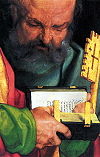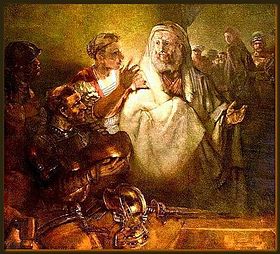v · Mark 14:69-70 is:
When the servant girl saw him there, she said again to those standing around, "This fellow is one of them." Again he denied it. [7]
The third denial to a number of people, is emphatic as he curses according to Matthew 26:73-75:
After a little while, those standing there went up to Peter and said, "Surely you are one of them, for your accent gives you away." Then he began to call down curses on himself and he swore to them, "I don't know the man!" Immediately a rooster crowed. Then Peter remembered the word Jesus had spoken: "Before the rooster crows, you will disown me three times." And he went outside and wept bitterly.[8]
The Gospel of Luke 22:61 describes the moment of the last denial as follows:
The Lord turned and looked straight at Peter. Then Peter remembered the word the Lord had spoken to him: "Before the rooster crows today, you will disown me three times." [9]
Following the resurrection of Jesus, the Gospel of John 21:15-17 narrates how Jesus asked Peter three times if Peter loved him, pointing to the rehabilitation of Peter following his repentance.[10]
Context and traditions
Context
For much of the period of three years that Jesus spent in ministry, gathering and teaching disciples, he had been observed, criticised and harassed by conservative scholars and priests. His teachings were sometimes seen as heretical and his actions in gathering a group of disciples as possibly having political motivation. Jesus' capture and trials were the culmination of this antipathy.
Peter was one of the twelve disciples most closely associated with Jesus. His denials are made in the face of accusation that he was "with Jesus", the term indicating the bond of discipleship. The Gospel of Matthew states that Peter denied Jesus "in front of everyone", thus making a public witness. Throughout his Gospel, Matthew stresses the importance of public witness as an essential element of discipleship, stating in Matthew 10:32-33: "Whoever acknowledges me before men, I will also acknowledge him before my Father in heaven. But whoever disowns me before men, I will disown him before my Father in heaven." Peter's denial is in direct conflict with the nature of discipleship, as described by Matthew.[11]
The New Testament descriptions of Peter's denial depict the drama of the incident. Peter's antagonists in the discussion of his discipleship progress from a maid, to a maid plus a bystander, to a whole crowd. His denial progresses from a plea of ignorance, to a denial plus an oath and then to cursing and swearing with a total denial that he ever knew Jesus. The sound of the rooster then brings a shock to Peter that Jesus had predicted the three denials.[12]
This episode has been seen as an incident that sheds light on the unique role of Peter and sets him apart from the other disciples, just as in the Gospel of Mark 16:7 in which the angel tells the women to "go and tell his disciples and Peter" about the resurrection of Jesus.[13] In this episode, as often elsewhere in the Gospel of Mark, Peter acts as the focus of the apostles, and an essential Christological image is presented: the denials of Peter contrast with the frank confessions of Jesus in his trial by the Sanhedrin, portraying his faithfulness as prophet, Son and Messiah.[14]
The triple denial of Peter is echoed in his triple refusal to eat the animals when he has a vision of a sheet with animals in Acts 10.[15]
Prayers and traditions
Bishop Lancelot Andrewes composed the following prayer:
O Lord Jesus Christ, look upon us with those eyes of thine where-with thou dist look upon Peter in the hall; that with Peter we may repent and, by the same love be forgiven; for thine mercy's sake. Amen.[16]
Referring to the tears shed by Peter during his repentance in the context of the Sacrament of Penance, Saint Ambrose said "in the Church, there are water and tears: the water of Baptism and the tears of repentance".[17] Traditionally, "tears of repentance", as exemplified by Peter, have become a symbol both of mourning and comfort: a sign at once of sins repented and forgiveness sought.[18]
In the Scriptural Way of the Cross introduced in 1991 by Pope John Paul II as a version of the Stations of the Cross, and performed each Good Friday at the Colosseum in Rome, the fourth station is the Denial of Peter.[19]
During Holy week in Jerusalem, vigils at times stop at a location traditionally considered the location for the Repentance of Peter, not far from the house of the high priest Caiaphas, involved in the Sanhedrin Trial of Jesus.[20]
In art

Repentance of Peter by El Greco,
1580-
1586.
The episode has been the subject of works of art for centuries. It has been depicted in a varieties of mediums and methods, ranging from 6th century mosaic at the Basilica of Sant'Apollinare Nuovo to Russian icons and oil paintings by many old masters. The subject was sometimes included in cycles of the Life of Christ or the Passion, often as the only scene not to include the figure of Christ.
In Rembrandt's depiction, now in the Rijksmuseum, Amsterdam, he presents the servant girl who recognizes Peter with a candle, illuminating Peter's face. Two soldiers look with suspicion as Peter speaks, while Jesus is shown in the distance, his hands bound behind him, turning to look at Peter. Peter's faces away from Jesus, and he gestures with his left hand, although his expression is free of defiance.[1]
Caravaggio's Denial of Saint Peter, is now at the Metropolitan Museum of Art in New York. Author George Weatherhead admires Caravaggio's depiction, the way Peter exhibits a wavering trepidation in his unsteady features, conscious of the unworthy falsehood he was telling. His lips quiver and his eyes seek, yet can not find the firmness of truth.[21] In this painting Caravaggio portrayed the servant girl using the same head of the woman that he used in his depiction of The Beheading of Saint John the Baptist.[22]
A related subject, the Repentance of Peter, showing the end of the episode, was not often seen before Catholic Counter-Reformation art, where it became popular as an assertion of the sacrament of Confession against Protestant attacks. This followed an influential book by the Jesuit Cardinal Robert Bellarmine (1542–1621). The image typically shows Peter in tears, as a half-length portrait with no other figures, often with hands clasped as at right, and sometimes the cock in the background; it was often coupled with a repentant Mary Magdalen, another exemplar from Bellarmine's book.[23]
Gallery of art
See also
Notes
- ^ a b The Biblical Rembrandt by John I. Durham 2004 ISBN 0865548862 163
- ^ Theological dictionary of the New Testament by Gerhard Kittel, Geoffrey William Bromiley, Gerhard Friedrich 1980 ISBN 0802822487 page 105
- ^ Peter: apostle for the whole church by Pheme Perkins 2000 ISBN 0567087433 page 85
- ^ The Gospel according to Matthew, Volume 1 by Johann Peter Lange 1865 Published by Charles Scribner Co, NY page 499
- ^ Bible gateway
- ^ Biblegateway
- ^ Biblegateway
- ^ Biblegateway
- ^ Biblegateway
- ^ Repentance in Christian theology by Mark J. Boda, Gordon T. Smith 2006 ISBN 0814651755 page 110
- ^ The Passion and Resurrection narratives of Jesus: a commentary by Stephen J. Binz 1989 ISBN 0814617719 page 54
- ^ The Collegeville Bible Commentary: New Testament by Robert J. Karris 1992 ISBN 0814622119 page 900
- ^ Peter: apostle for the whole church by Pheme Perkins 2000 ISBN 0567087433 page 65
- ^ Prophet, Son, Messiah: narrative form and function in Mark 14-16 by Edwin Keith Broadhead 1994 ISBN 1850754764 page 154
- ^ Ben Witherington, The Acts of the Apostles: A Socio-Rhetorical Commentary (Grand Rapids: Eerdmans, 2008), 350.
- ^ Prayers for People Under Pressure by Jonathan Aitken 2006 ISBN 0826482759 page 58
- ^ Vatican website, Catechism item 1429
- ^ Repentance in Christian theology by Mark J. Boda, Gordon T. Smith 2006 ISBN 0814651755 page 223
- ^ Vatican website Fourth Station: Jesus is denied by Peter
- ^ The week of salvation: history and traditions of Holy Week by James Monti ISBN 0879735325 page 150
- ^ A pedestrian tour through France and Italy by George Hume Weatherhead 2009 ISBN 1150139412 page 232
- ^ Caravaggio: the art of realism by John L. Varriano 2006 ISBN 0271027177 page 110
- ^ Hall, pp. 10 and 315
References
- James Hall, A History of Ideas and Images in Italian Art, 1983, John Murray, London, ISBN 0719539714
Categories: - Gospel episodes
- Biblical apostles
- New Testament narrative
- Apostle Peter
- Christian iconography
Wikimedia Foundation.
2010.
Look at other dictionaries:
Peter Janssen — (18441908) was a German historical painter. He was born at D uuml;sseldorf, son of the engraver Theodor Janssen (181794), by whom he was first instructed before studying at the Academy under Karl Sohn (Ger. wiki) and Bendemann. He is principally… … Wikipedia
Peter Dupas — Background information Birth name Peter Norris Dupas Born 6 July 1953 (1953 07 06) (age 58) … Wikipedia
Denial (1998 film) — Denial Film poster Directed by Adam Rifkin Produced by Peter Abrams Louise Ro … Wikipedia
Peter Sagal — is an American playwright, screenwriter, actor, and host of the National Public Radio game show Wait Wait... Don t Tell Me! He is originally from Berkeley Heights, New Jersey, although he currently resides in a suburb of Chicago. Sagal attended… … Wikipedia
Peter Hugh McGregor Ellis — Peter Ellis Peter Ellis, 1992 Born 30 March 1958 Peter Hugh McGregor Ellis (born 30 March 1958) is a former Christchurch child care worker who has been at the centre of one of New Zealand s most enduring judicia … Wikipedia
Peter Cooper Village—Stuyvesant Town — is a large private residential development on the East Side of the borough of Manhattan in New York City. One of the most iconic and successful of post war private housing communitiesFact|date=June 2007, Stuyvesant Town was planned in 1943. [… … Wikipedia
Peter James (writer) — Peter James in March 2010 Peter James (born 22 August 1948 in Brighton) is a British writer of crime fiction and film producer. Contents 1 … Wikipedia
Peter James — (* 22. August 1948 in Brighton) ist ein englischer Schauspieler, Drehbuchautor, Filmproduzent und Schriftsteller. Seine Schulzeit verbrachte James an der Charterhouse School … Deutsch Wikipedia
Peter James — au Salon du livre de Paris en mars 2010 Peter James, né le 22 août 1948 à Brighton, dans le comté de West Sussex, est un écrivain et producteur de cinéma britannique … Wikipédia en Français
Peter Westerstrøm — (1779 1809) was a Swedish mass murderer who gained notoriety for the Saksebøl Slaughter in Moss, Norway during the Napoleonic wars.BackgroundPeter Westerstrøm was born in Ljungby in Sweden around 1778. His father Jonas was the local sexton, but… … Wikipedia











